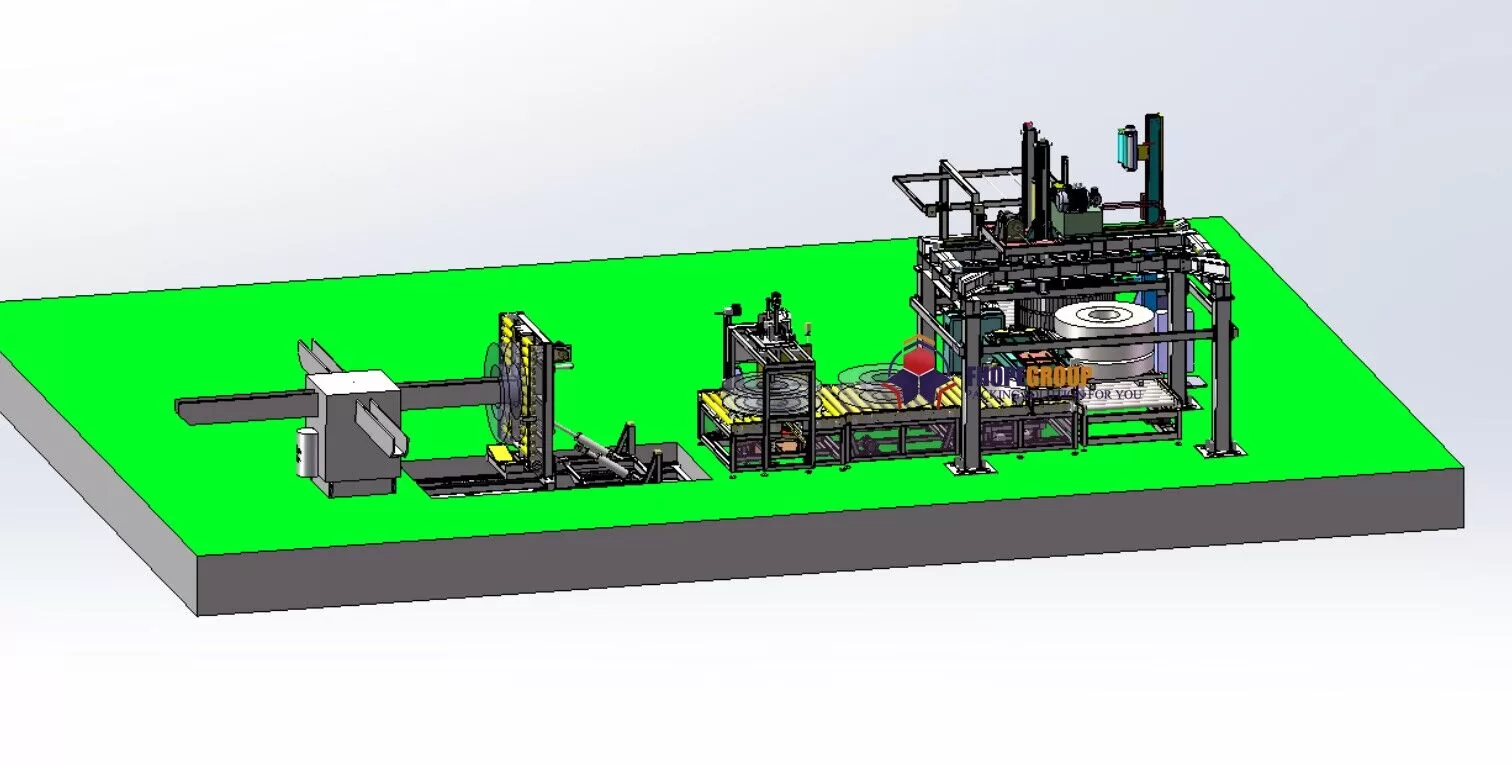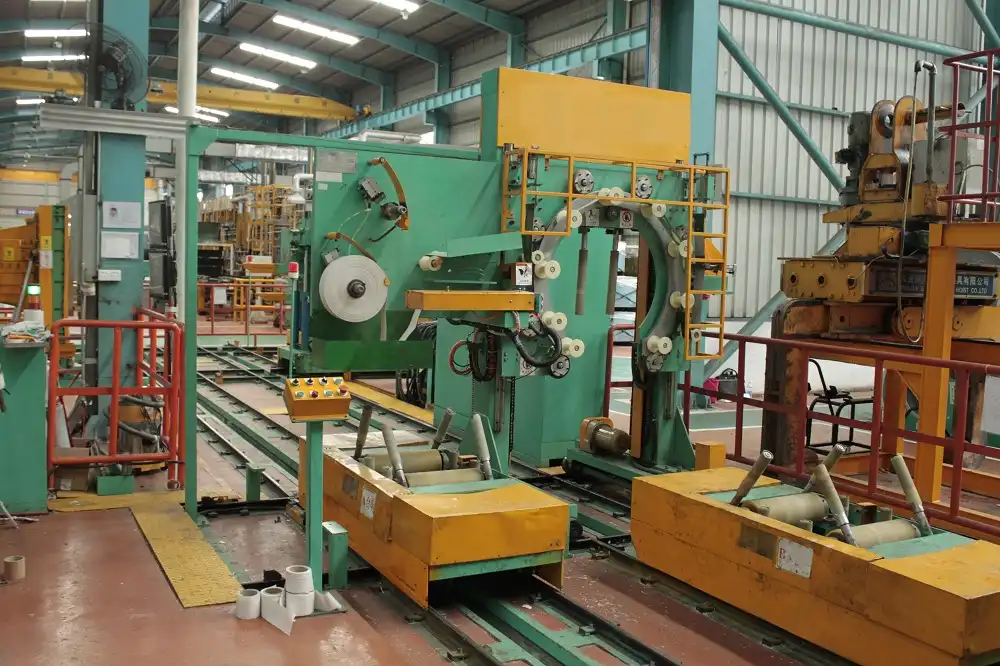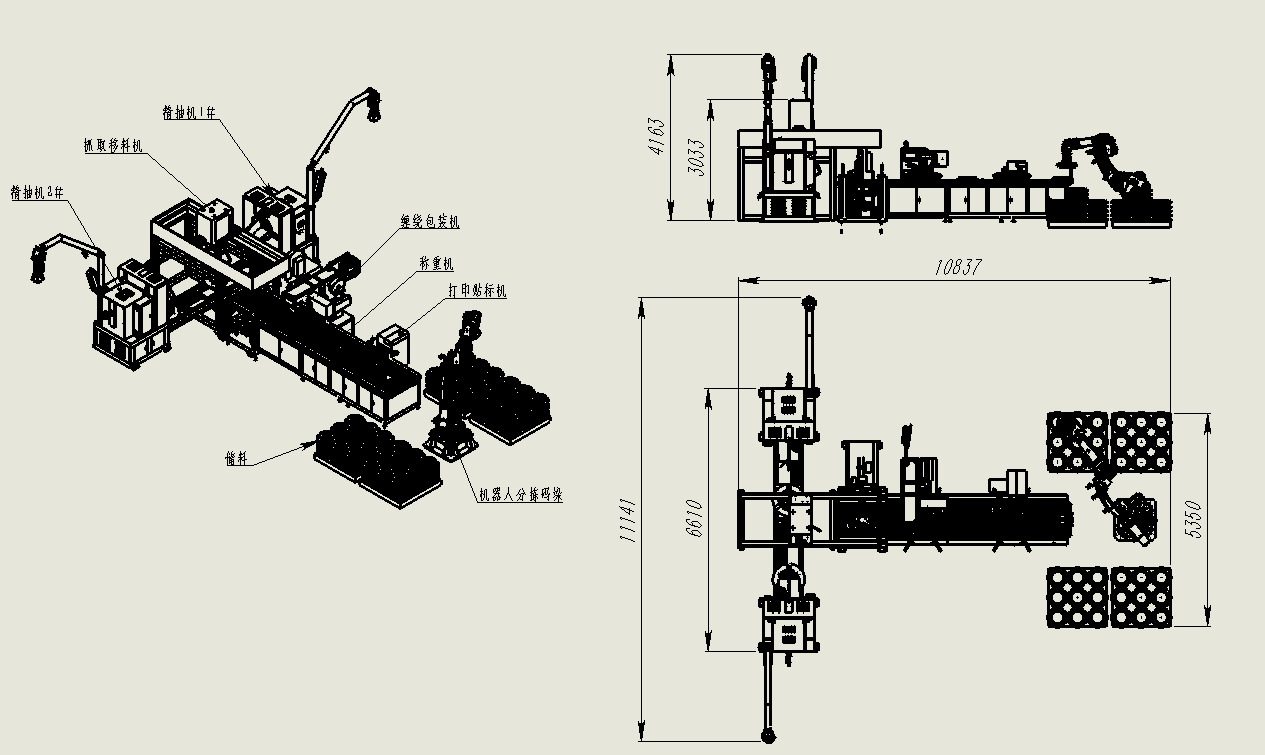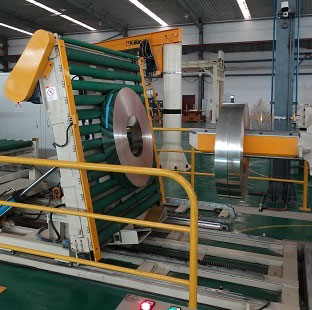Your steel mill is a powerful, non-stop operation. But what happens when the final step, the packing line, breaks down? Everything grinds to a halt. Production stops. Trucks sit idle. Your shipping schedule is thrown into chaos. This single point of failure at the end of your line can jeopardize the efficiency of the entire plant. You see the maintenance logs, you feel the pressure of rising repair costs, and you know that aging equipment is a ticking time bomb threatening your uptime goals and your bottom line. What if your packing line was not a liability, but a strategic asset? A modern, automated system could be the key to unlocking new levels of reliability and efficiency, turning a potential bottleneck into a smooth, dependable process.
The best way to avoid downtime is by investing in a robust, automated coil packing line designed specifically for high-volume steel production. These systems minimize manual intervention, use reliable and globally-sourced components, and integrate predictive maintenance features. This ensures your finished products keep moving without interruption, protecting your entire production schedule.

I have spent my entire career in the packing machine industry, first as an engineer and later as a factory owner. I have seen this exact scenario play out time and time again. The solution is about more than just buying a new machine. It is a fundamental shift in how you think about the end of your production line. It is about transforming a cost center into a reliable part of your growth strategy. Let's break down how this works and what it means for a modern steel mill owner like you.
How can upgrading your packing line directly combat rising equipment failures?
Your 15-year-old packing machine feels like a constant battle. A bearing fails here, a sensor goes out there. Each time it breaks down, it costs you precious hours of production and thousands of dollars in emergency repairs and labor. You are stuck in a reactive cycle, always fixing what just broke. A modern packing line is built differently. It is engineered from the ground up to prevent these failures before they happen, giving you control over your operations.
Upgrading your line replaces worn-out, fatigued mechanical parts with modern, durable components designed for 24/7 operation. This simple change drastically increases the Mean Time Between Failures (MTBF). More importantly, automation removes inconsistent manual operations, which are a very common source of equipment damage and unexpected stoppages. A well-designed system delivers predictable, repeatable performance, day in and day out.

From Reactive Repairs to Proactive Reliability
An old packing line often forces you into a reactive maintenance mode. You wait for something to fail, then you rush to fix it. This approach is costly and unpredictable. You stock a wide range of spare parts because you never know what will fail next. Your maintenance team is always putting out fires instead of preventing them. This is the definition of operational inefficiency.
A new, well-engineered coil packing line is designed for proactive reliability. The focus shifts from fixing to preventing. The machine is built with higher quality materials and components that have a longer, more predictable lifespan. This isn't just about using better steel; it's about intelligent design that minimizes wear and tear on critical parts like rollers, belts, and wrapping heads. This design philosophy is the first step toward achieving your goal of 95% equipment uptime. You move from hoping the machine runs to knowing it will.
The Critical Components that Make the Difference
The reliability of a packing line comes down to the quality of its components and the intelligence of its control system. In my experience building these machines, I've learned that you cannot cut corners here. The difference between a line that runs for a decade and one that causes headaches after a year is in the details.
We insist on using globally recognized brands for key parts. This means control systems from Siemens or Allen-Bradley, which are familiar to most industrial maintenance teams. It means using durable motors, high-precision sensors, and robust bearings that are built to withstand the harsh environment of a steel mill. A cheaper, no-name component might save a little money on the initial invoice, but it will cost you far more in downtime and replacement parts over the life of the machine.
Here’s a simple comparison:
| Feature | Old Packing Line (>15 years) | Modern SHJLPACK Line |
|---|---|---|
| Control System | Basic relays or outdated PLC | Siemens/Allen-Bradley PLC with HMI |
| Motors & Drives | Standard efficiency, prone to wear | High-efficiency, variable frequency drives (VFDs) |
| Sensors | Simple mechanical limit switches | Non-contact proximity and photoelectric sensors |
| Maintenance | Reactive (Fix when broken) | Proactive & Predictive (Schedule based on data) |
| Failure Mode | Sudden, unpredictable breakdowns | Graceful degradation, with advance warnings |
By investing in a line with these superior components, you are not just buying a machine. You are buying predictability. You are buying peace of mind.
As a CEO, you track the big expenses: energy, raw materials, and labor. But in an aging packing process, there are dozens of smaller, hidden costs that quietly eat away at your profit margin. Think of the extra wrapping material used because of inconsistent manual application. Think of the small but frequent production stops that never make it into a major report. Or the potential safety risks that come with manual handling of heavy coils and strapping tools. These costs add up significantly.
Automation brings these hidden costs into the light and then systematically eliminates them. An automated system uses the exact amount of wrapping material needed for each coil, not an inch more. It reassigns skilled labor from repetitive, low-value packing tasks to more critical roles like quality control or machine supervision. Most importantly, it creates a smooth, continuous flow from your production line to the shipping bay, slashing the bottlenecks that secretly steal your capacity.

Uncovering the True Cost of Your Current Process
Let's be honest about the real costs of a semi-manual or outdated packing line. It's not just the salary of the workers at the end of the line. It's much deeper. First, there's material waste. A human operator, no matter how skilled, will never apply wrapping film or paper with the perfect consistency of a machine. This often leads to over-wrapping "just to be safe," which can waste thousands of dollars in consumables per year. Second, there's the cost of inconsistent quality. A poorly wrapped coil can be damaged during transit, leading to customer complaints and costly returns. Third, there is the significant cost of safety. Manual strapping and handling of coils carry an inherent risk of injury, which can lead to workers' compensation claims and lost productivity. These are the "death by a thousand cuts" expenses that a simple P&L statement might miss, but they directly impact your goal of improving profit margins.
Automation's Direct Impact on Your Bottom Line
Achieving an 8% reduction in overall operating costs is an ambitious goal. The packing line is the perfect place to start making a real impact. A fully automated coil packing line addresses these hidden costs directly. A PLC-controlled wrapping system calculates the precise overlap and number of layers required for each specific coil size, cutting material consumption by as much as 30%. Automated strapping machines apply straps with consistent tension at the exact right positions, improving load security and eliminating manual labor. Conveyor systems, turnstiles, and stackers handle the coils smoothly and safely, dramatically reducing the risk of accidents and product damage.
Let's look at a practical cost analysis:
| Cost Category | Manual / Old Process | Fully Automated SHJLPACK Line | Potential Impact |
|---|---|---|---|
| Labor | 2-3 operators per shift for wrapping/strapping | 1 supervisor per shift | Reassign 1-2 FTEs to higher-value tasks |
| Material Usage | High (inconsistent over-wrapping) | Optimized (precisely controlled) | 15-30% reduction in consumable costs |
| Product Damage | Higher risk during handling/transit | Minimal risk due to secure, consistent wrapping | Fewer customer claims, improved reputation |
| Safety Incidents | Higher risk of strains, cuts, and injuries | Drastically reduced risk | Lower insurance premiums and lost time |
When I work with clients like Javier, we don't just sell a machine. We analyze their entire end-of-line process to identify these hidden costs. The goal is to design a system where the savings in labor, materials, and safety quickly justify the initial investment. This is how you turn a necessary process into a competitive advantage.
How does a "smart" coil packing line fit into a fully digitalized steel mill?
You are already investing in a digital future for your mill with MES and big data platforms. That is a forward-thinking strategy. But if your packing line at the very end of the process is a "dumb" machine, you have a critical blind spot. You can track a coil through the furnace and the rolling mill with perfect clarity, but the moment it hits the packing area, it enters a black hole. You lose visibility. A "smart" coil packing line closes this gap.
A smart coil packing line is not just a wrapper; it is a vital data node in your digital ecosystem. It is equipped with IoT sensors and a powerful PLC that communicates directly with your Manufacturing Execution System (MES). It provides real-time, actionable data on throughput, cycle times, material consumption, and machine health. This gives you complete, end-to-end visibility of your production process and is the foundation for data-driven decision-making.

More Than a Machine: A Data Generation Hub
In a modern factory, every piece of equipment should contribute to your data strategy. A smart packing line is designed to do exactly that. It goes beyond basic operation. It's equipped with a suite of sensors that monitor every aspect of its performance. We're talking about sensors that track motor temperature and vibration, power consumption, the exact amount of wrapping film used per coil, and the number of strap cycles. This data is collected by the onboard PLC and is displayed on a user-friendly Human-Machine Interface (HMI).
But the real power comes when this data is sent to your central systems. Your maintenance team can see a motor's temperature trending upwards and schedule a check before it fails. Your procurement team gets precise data on wrapping material consumption, allowing for better inventory management. Your production manager can see the exact throughput of the packing line in real-time and identify potential bottlenecks before they impact the entire mill. This is how you move toward your goal of 95% effective run time. You use data to see the future, not just react to the past.
Connecting the Dots: MES Integration and Predictive Maintenance
The true value of a smart line is unlocked through its integration with your MES. This connection turns raw data into powerful insights. When a coil arrives at the packing line, its ID is scanned. The MES then tells the packing line the exact "recipe" for that coil: what wrapping material to use, how many layers, and the strapping pattern. Once the coil is packed, the line sends a confirmation back to the MES, along with all the process data it collected. That coil is now tracked, from creation to shipment, with a complete digital history.
This data is the fuel for a predictive maintenance program. Your systems can analyze trends and flag potential issues long before a human would notice them.
| Data Point from Smart Line | Impact on Mill Operations |
|---|---|
| Vibration Sensor Data | Predicts bearing or motor failure. Enables scheduled replacement. |
| Film/Paper Consumption | Allows for just-in-time inventory ordering. Prevents stockouts. |
| Cycle Time per Coil | Identifies efficiency drops or mechanical slowdowns. |
| Fault Code History | Helps maintenance diagnose recurring issues and find root causes. |
I've seen clients transform their maintenance from a chaotic, reactive process to a calm, scheduled one. This is not a fantasy. It is the practical application of technology that is available today. For a leader like Javier, who understands the power of data, a smart packing line isn't an option; it's a necessity for building a truly modern and efficient steel mill.
Why is choosing a strategic partner more critical than just buying the cheapest machine?
When you are looking at a major capital investment, it is always tempting to focus on the price tag. The lowest bid often seems like the most financially responsible choice. But I have learned a hard lesson over my 25 years in this business: the cheapest machine almost always has the highest total cost of ownership. What happens when you need technical support for an integration problem? What if you need to modify the line in five years to handle a new product? The vendor who sold you the cheapest box is often nowhere to be found. You are left alone with a machine that doesn't quite fit your needs.
A strategic partner, on the other hand, invests in your success for the long term. They provide deep expertise not just during the sale, but through system design, installation, operator training, ongoing maintenance, and future planning. This partnership ensures your investment delivers the maximum possible return and can adapt as your business grows and changes. It is the difference between buying a tool and investing in a solution.

The Full Lifecycle of an Equipment Investment
A coil packing line should be a 15- to 20-year asset in your plant. The initial purchase price is only one part of that long journey. A true partner understands and supports you through the entire lifecycle.
- Consulting & Design: This is the most critical phase. A partner doesn't just show you a catalog. They come to your plant. They study your workflow, understand your specific challenges, and talk to your operators. We work with you to design a solution that fits your space, your product mix, and your long-term goals, like digitalization and environmental compliance.
- Installation & Commissioning: This is more than just dropping a machine on the floor. It's about seamless integration with your existing conveyors and control systems. A partner ensures the line is commissioned properly and running at peak efficiency before they consider the job "done."
- Training: A new machine is only as good as the people who run it. A partner provides comprehensive training for your operators and maintenance staff, empowering them to run the line safely and handle basic troubleshooting.
- Ongoing Support & Maintenance: When you have a problem, you need an answer. A strategic partner provides reliable after-sales support, spare parts availability, and expert advice to keep you running.
- Future-Proofing: Your business will change. A partner helps you think ahead, designing a system that is modular and can be upgraded or modified in the future to meet new demands.
What to Look For in a True Partner
When I was an employee in a factory, I saw the frustration that came from working with suppliers who disappeared after the check was cashed. When I founded my own company, SHJLPACK, I vowed to be the kind of partner I wish we'd had back then. So, what should a leader like Javier look for? First, look for deep industry experience. Do they understand the unique challenges of a steel mill? Second, look for a willingness to customize. Your plant is unique; you need a solution, not a standard product. Third, ask hard questions about their after-sales support system. Who will you call, and how quickly will they respond? Finally, look for a shared vision. Do they understand your goals for efficiency, digitalization, and long-term growth? Are they interested in helping you achieve them? A partner shares your risk and is invested in your success. This is the foundation of a relationship that delivers value for years to come.
My Insights: A Machine is a Tool, but the Right System is a Strategy
I started my journey on the factory floor as an engineer. I saw firsthand how a poorly designed or unreliable machine could cause stress and frustration for everyone, from the operator to the plant manager. Later, when I took the risk to build my own packing machine factory, I carried those lessons with me. I achieved financial independence not just by selling machines, but by solving problems for my clients. I saw that when I helped their businesses grow and become more efficient, my own business thrived.
Now, my mission with SHJLPACK is to share that knowledge. For a leader like Javier, who has also risen through the ranks and understands the business from the ground up, this perspective is crucial. The coil packing line is not the end of your process. It is the last touchpoint you have with your product before it reaches your customer. A perfectly packed, secure, and professionally presented coil is a promise. It tells your customer that you care about quality, all the way to the very end.
Investing in a modern, automated packing system is not an operational expense to be minimized. It is a strategic investment in your brand, your efficiency, and your future. It's how you protect your uptime, lower your real costs, and build a plant that is ready for the next decade of competition.
Conclusion
A reliable packing line is not an expense; it is a core asset for uptime and profitability. Partner with an expert to build a system that secures your plant's future.




